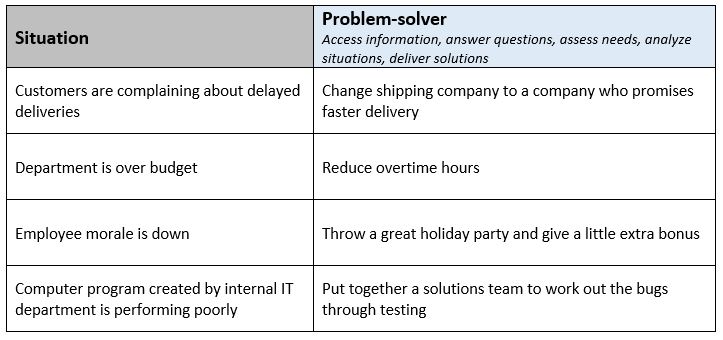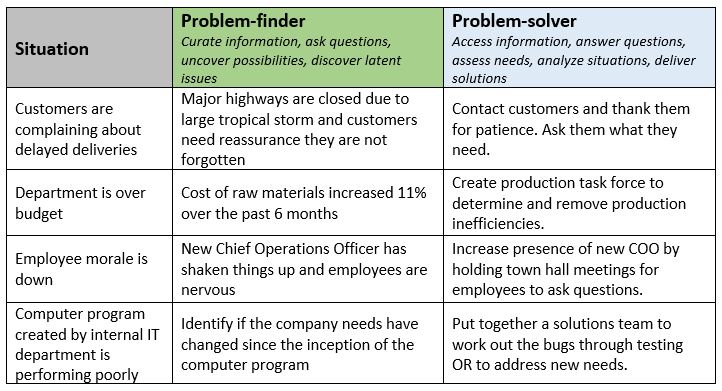Hours of meetings, research, and effort ONLY to find out it was the WRONG problem.
I remember this happening with a client a number of years ago when I delivered training on employee engagement. The goal of the training was to “empower employees to work together better by building trust with each other”. Great!
I developed a program with some of my best stuff on conflict resolution and working together to identify best practices. Then … the training sort of flopped. Oh. My. Gosh. How could I let the client down? I felt resistance from the client’s employees (and a little shame on my part). How could I let this happen?
Here is the reason why. Turns out I didn’t understand the real problem. Neither did the client. From the perspective of the client’s employees, the issue was not a lack of trust between the employees themselves, it was a lack of trust with leadership. Leadership didn’t see this, and they hadn’t asked the right questions. Nor did I. We were solving the WRONG problem.
In his book To Sell is Human, author Daniel Pink explains that we need the “capacity to help others see their situations in fresh and more revealing ways and to identify problems they didn’t realize they had.” (p. 125.) I needed to help leadership see that the trust problem involved them. I was problem-solving by answering their questions when I should have been problem-finding by asking questions. Take a look at these examples of what often happens when we move directly to answering questions when a problem exists.

Let’s back it up now and make sure we FIND THE PROBLEM FIRST.

See how the solutions are different? That is because the real problem has been found. If I had found the right problem for the client, the training I designed and delivered would have been different too. I’m not saying I would have thrown the baby out with the bath water so-to-speak; however, I would have asked questions to leadership that would have helped us to realize the problem they didn’t know they had.
So, what are the right questions to solve for the right problem? There are a lot of useful approaches but allow me to suggest this one.
- What are the surface problems (i.e., symptoms that grow from the deeper issue or problem such as: tardiness, complaining, low customer satisfaction scores, lack of communication etc.)?
- What are the root problems (i.e., origin, source, or cause of surface problems that are underneath such as: long work hours, unrealistic expectations, unwritten policies etc.)?
- Observation: What are the facts?
- Analysis: What patterns have emerged?
- Inference: What conclusions can be made from the facts and patterns?
- What is the problem to be solved?
Now, if I used this approach with the client I mentioned earlier, we would have likely realized that we were solving for the surface problem, not the root problem. It might have looked like this.
- What are the surface problems?
- Team members are talking behind each other’s backs and not working together.
- Employees are blaming each other which is producing a lack of accountability.
- Work isn’t getting done because employees aren’t working together.
- What are the root problems? (In other words, what is causing the surface problems?)
- Employees are allowed to talk behind each other’s backs; boundaries are not being set by leadership.
- Employees don’t trust each other because they are allowed to blame and talk behind each other’s backs; boundaries are not being set by leadership.
- Observation: What are the facts?
- There are no consequences for unacceptable/unprofessional behavior.
- Frequent policy and leadership changes are happening
- Analysis: What patterns have emerged?
- Leadership changes are causing inconsistency
- Inference: What conclusions can be made from the facts and patterns?
- Changes in leadership are creating inconsistency, confusion, and lack of trust.
- What is the problem to be solved?
- Employees have lost trust in leadership.
Wow, I needed to be training leadership, not the people they lead! Lesson learned. GOOD NEWS! After aiming at the wrong target, leadership was willing to do some work to earn trust back.
If you enjoyed learning about solving for the right problem, check this out about solving the problem of a disengaged employee AND if you are curious about rising above a mistake, read this!









Leave A Comment